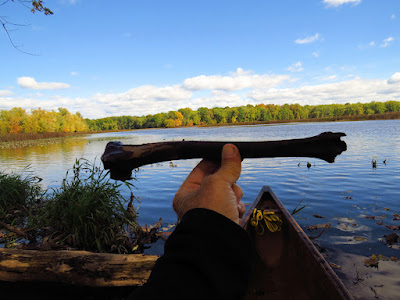A minor plumbing fix diverted my attentions to closer to home waters. I put in at the town harbor in a light sprinkle coming down from a thick overcast. The tide has just peaked and the wind is near calm. There is not another boat moving in the harbor.
I spot two Common Loons before even getting out of the harbor, a distance of 2/3 mile. Then I turn up Gulf Pond, also know as the Indian River, and formerly known as the East River, when it was the eastern boundary of the Milford Colony. Gulf Pond/Indian River can be broken up into three geographical segments. Right at the mouth of the harbor, one passes under a bridge into the lower pond. Time that wrong and you might not be able to break the tidal current, although most of the time one can make it with some effort. A thousand yards up, one passes under another bridge, again with a potential fast tidal current - pretty much the same story as the lower bridge. This second pond is about a half mile long. At the top is a low road bridge, which doesn't have any problems with current. There is, however, an issue at very high tides when a canoe will not fit underneath. Just 50 yards up is the key to getting into the third section. This is a railroad bridge, and like most railroad bridges in this area, it was built over a hundred years ago with no regard for the health of the marsh. These old bridges badly constrict tidal water exchange. The bottom under the bridge is jagged boulders, so low tide is a nasty carry. Ideally, one times this bridge so that you enter just before or near high tide. There is about a mile and a half of river to explore above that until one gets to a fish ladder, although one mile up is another very low road bridge that is not passable during a normal high tide. Time the whole trip right, and the return trip is easy with a fast drop under the railroad.This week, I figured out more about the Native American village sites. It turned out that I had an 1835 map of Milford in my records, and there I found the missing Old Field Swamp, which is still there, although without the old name. An archaeology report had tipped me off that a village was located between the Old Field Swamp and Indian River. The map even labeled a "Indian Burial Place", which was exactly between the swamp and the river. I'll just guess that the village was on the nearby high ground, and that a whole neighborhood of 1950's houses are built on an Indian burial ground.
I made my way all the way up to the very low road bridge, which was still a good two inches too low for the canoe. On the way back, I spotted a third Common Loon in the lower pond. It was fishing and kept its distance by swimming ahead of me until I got near the bottom of that section, whereupon it vamoosed.
Back in the harbor, I found two Loons together. They were more or less resting, so they must have already ate well. They called to each other with a soft moan, not at all what most people think of as Loon calls. I spotted a fourth Loon (I'm pretty sure the pair was a repeat sight) near my take out.





















































